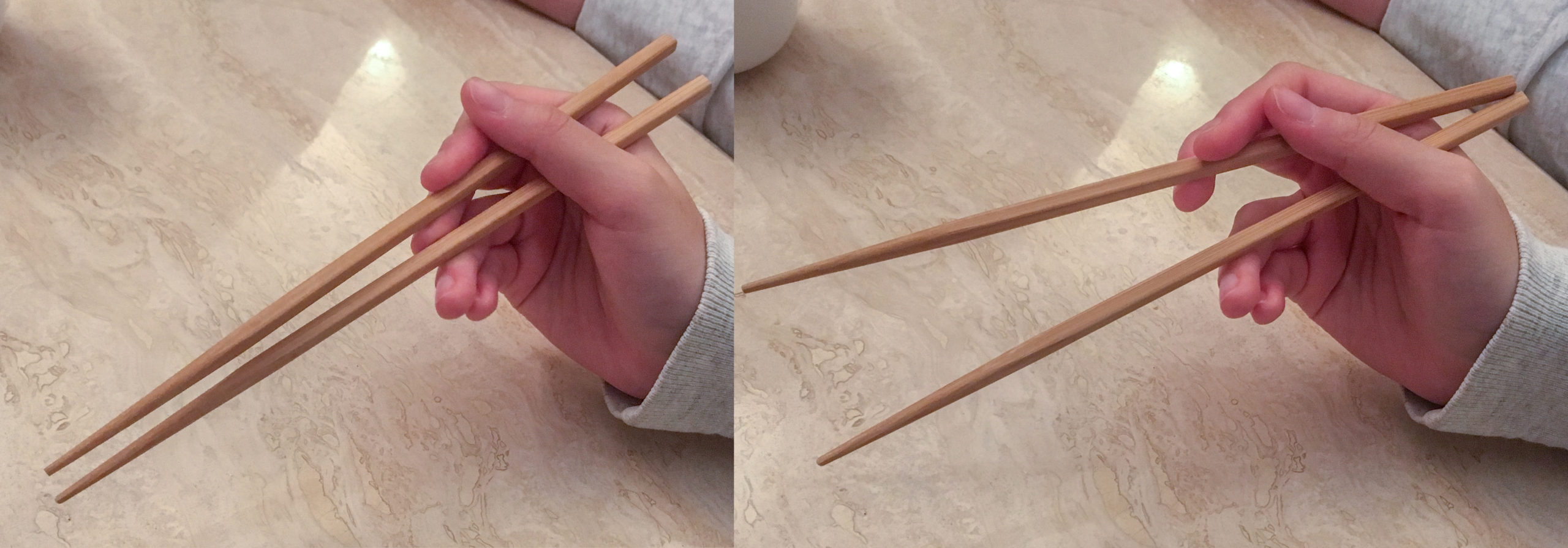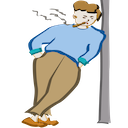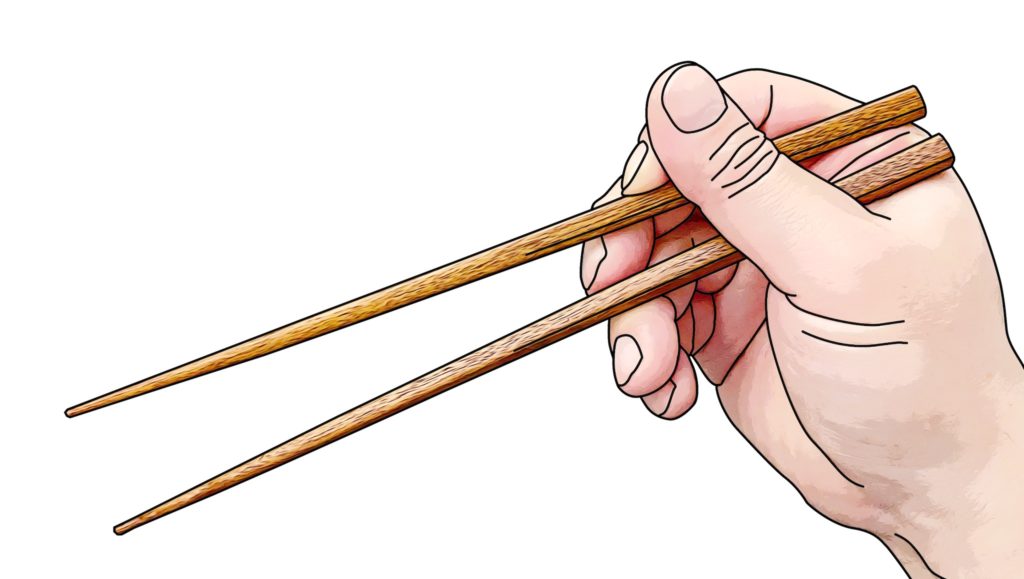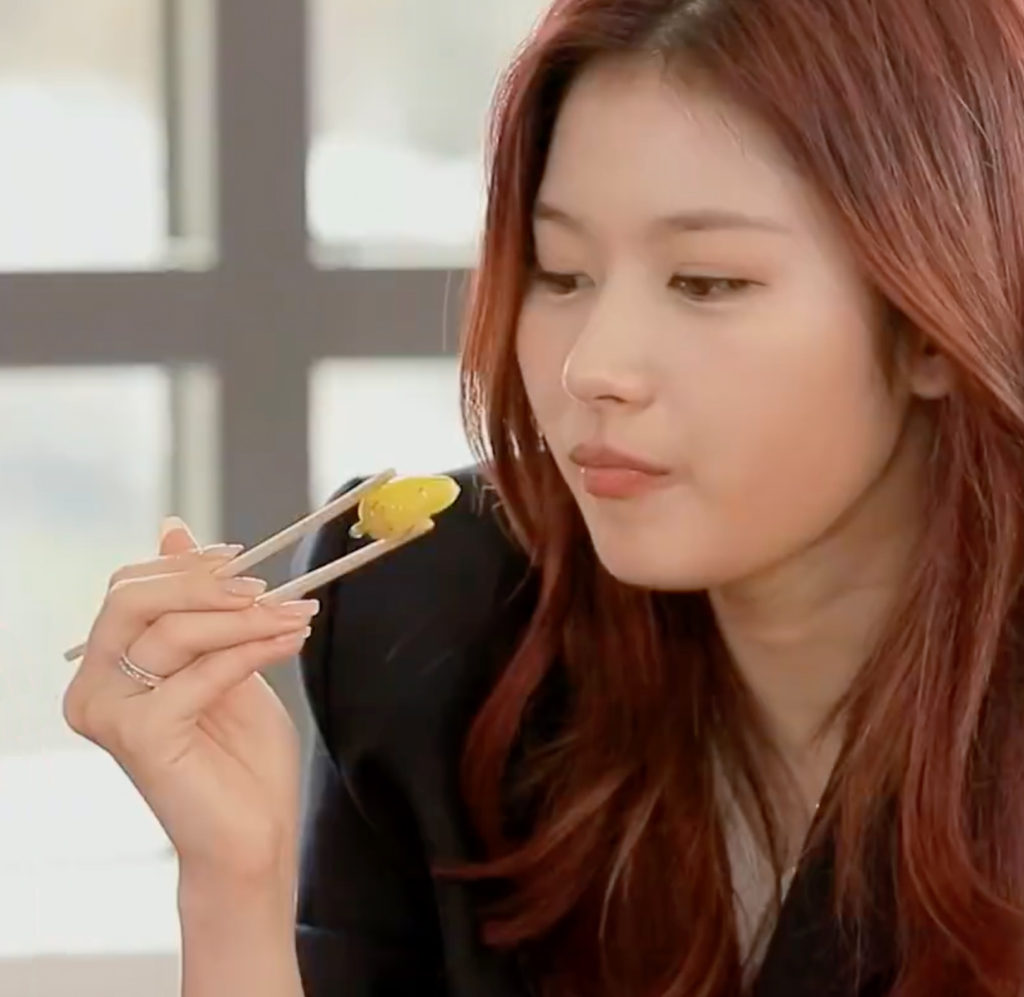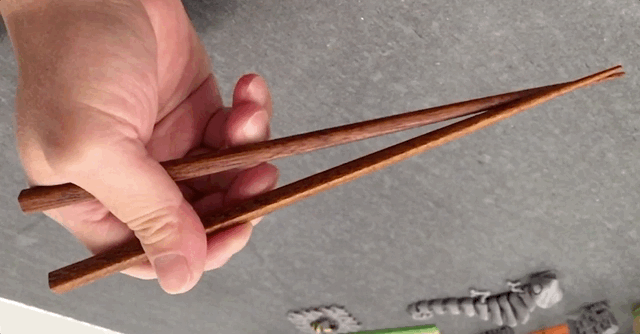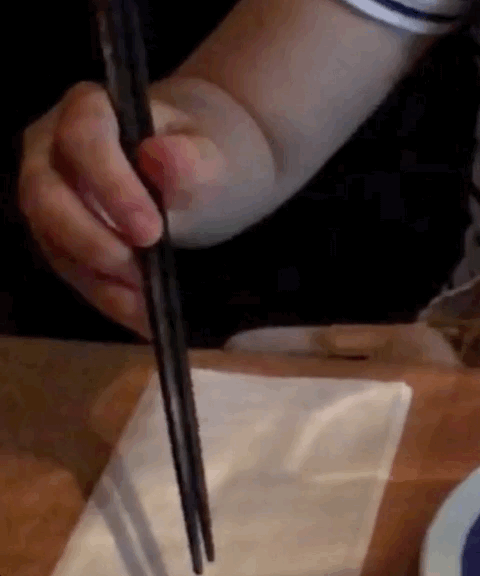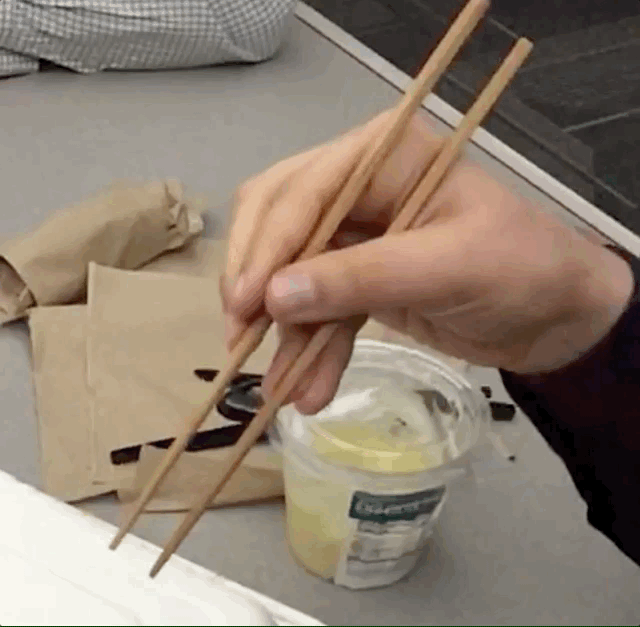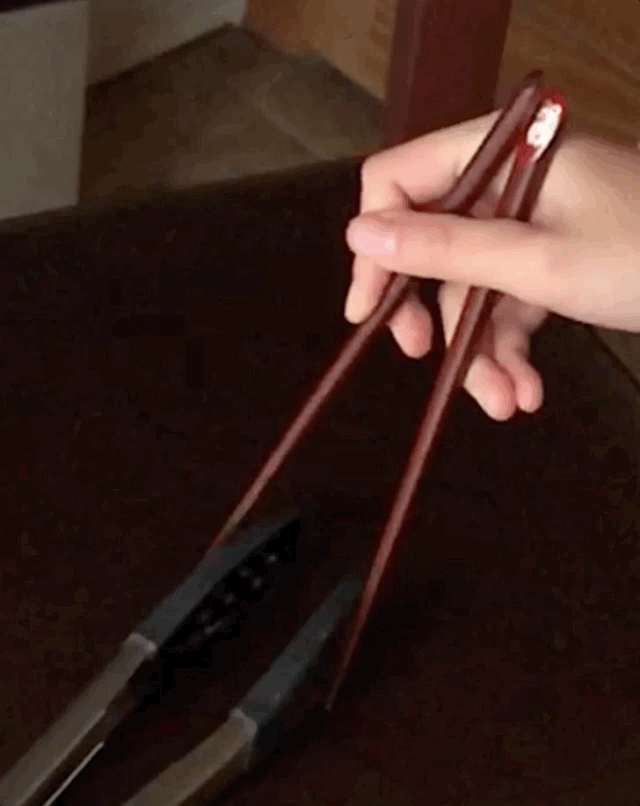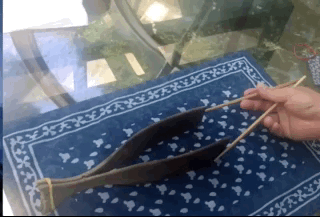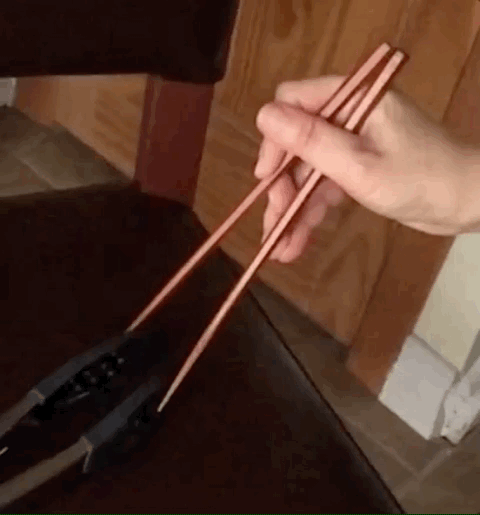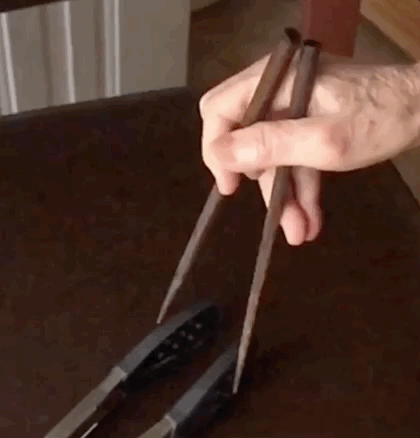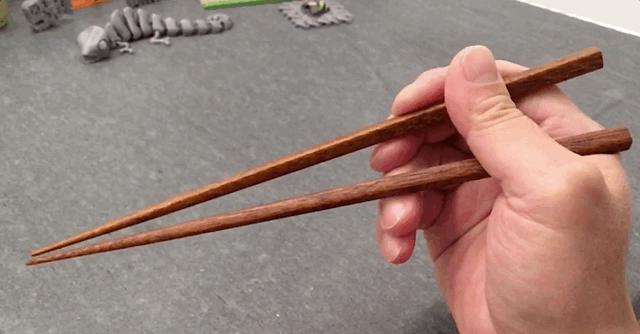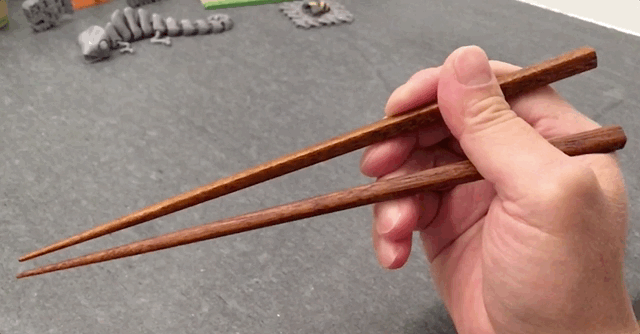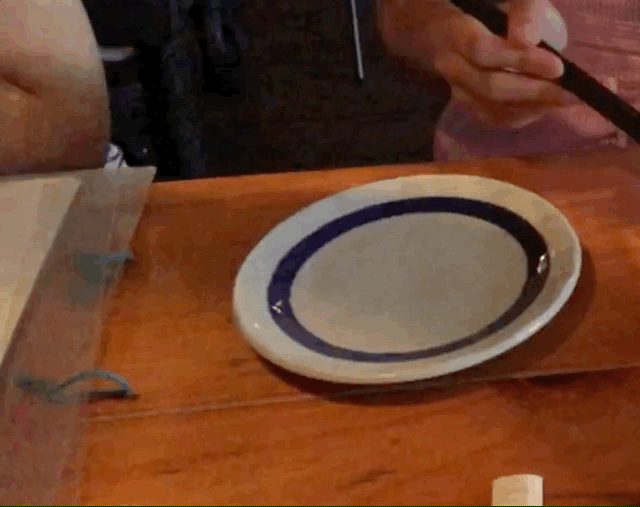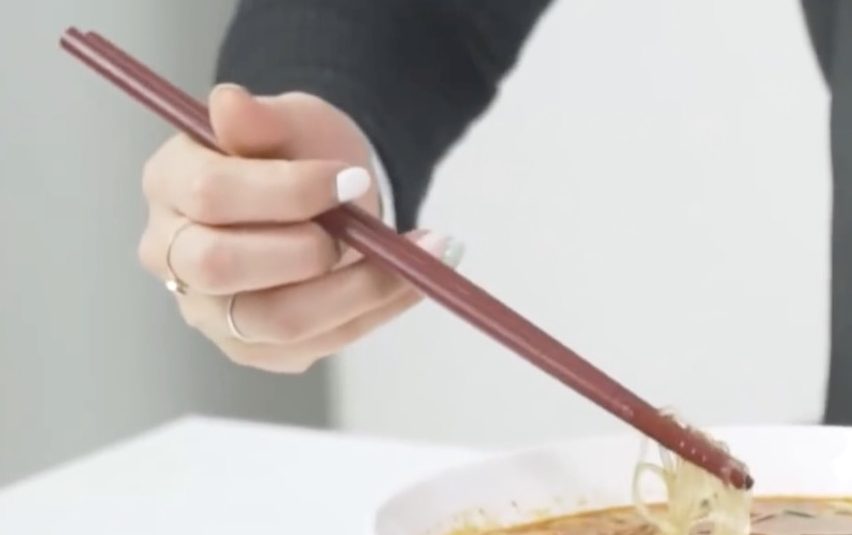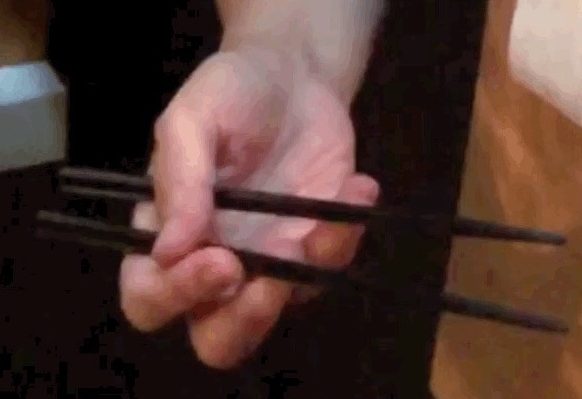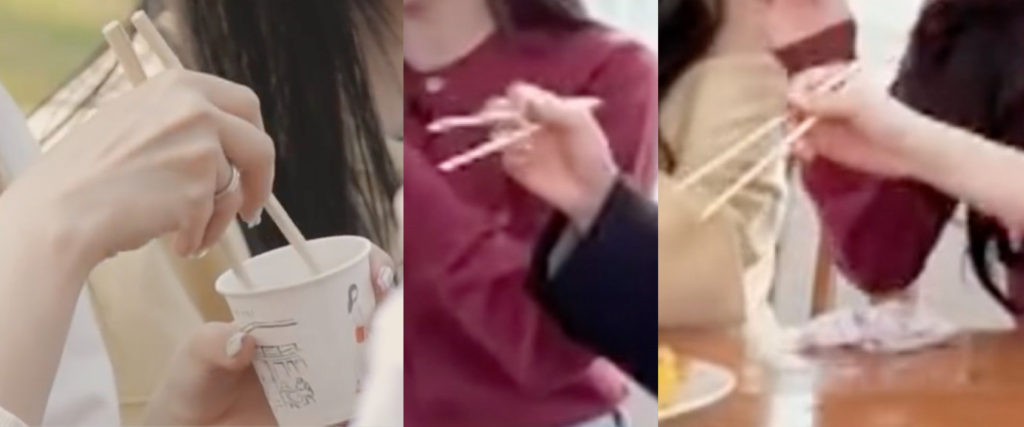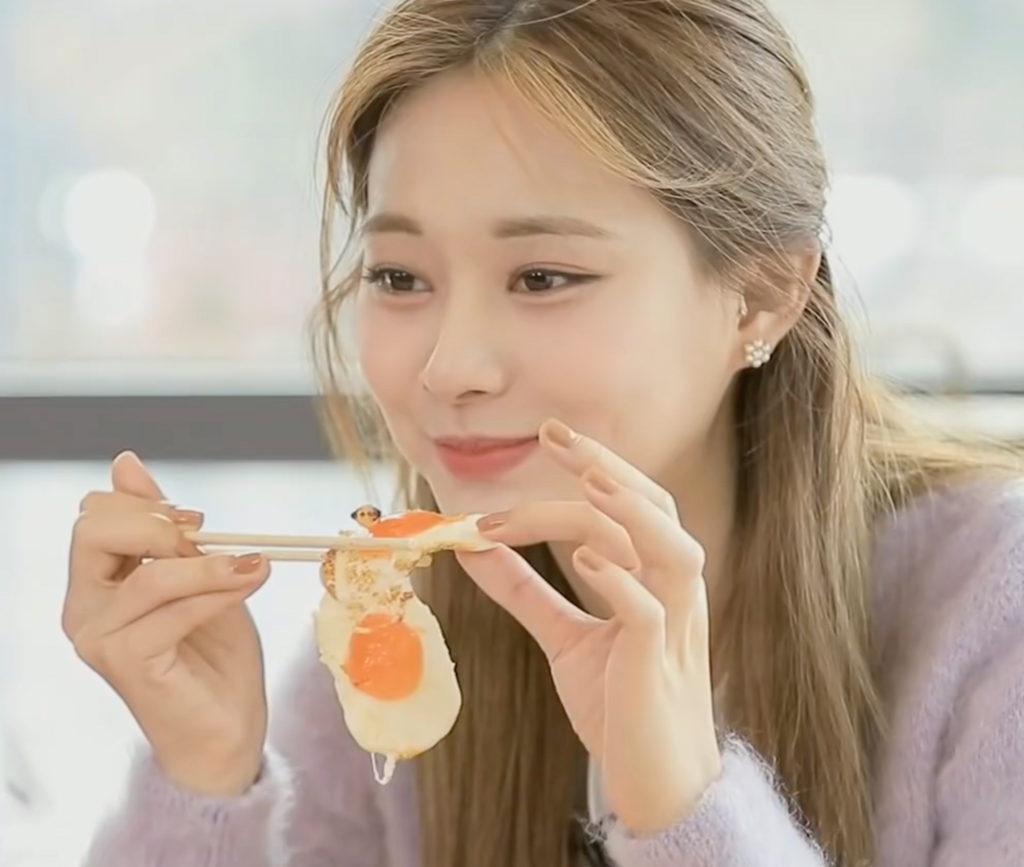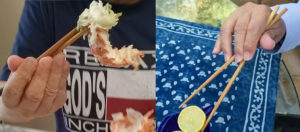Last Updated on August 22, 2021 by Staff
For a long time the staff here at marcosticks.org were fooled by the Idling Thumb grip. We took many documented uses of this grip to be the Standard grip. This grip looked, at a glance, like the standard grip. Its finger placement and motion almost look like the twirling of chopsticks in the standard grip. But in real eating situations, it revealed its true self, through the lack of chopstick reach and power.
Video footages of test subjects trying and failing to close or open salad tongs lead to further research into this matter. Finally we came to realize that this pseudo standard grip is just one step away from being a true standard grip. In this grip, the thumb remains unemployed.
Table of Contents
Idling Thumb vs. Standard Grip
Study the two versions of the closed posture shown below. The Idling Thumb version is found on the left, and the Standard Grip version is found on the right. Recall that the closed posture captures the finger configuration for closing tips of the two chopsticks on some food item, and for applying compression forces on said item to securely hold it between tips. If one were to start with the standard grip version on the right, and relief the thumb of duties involving the manipulation of the top chopstick, then fingers and chopsticks may look like the Idling Thumb version on the left.
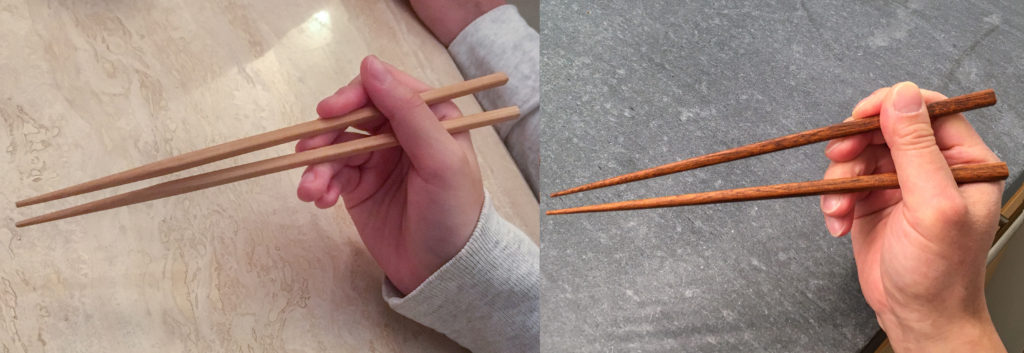
The key difference between these two grips is that in the Idling Thumb grip, the tip segment of the thumb remains useless, especially at the closed posture shown above. Only the base segment of the thumb is used – it holds both top chopstick and bottom chopstick in place. This change significantly reduces the distance between the two chopsticks, at the closed posture. As a result of this shortened distance, the rear ends of the two chopsticks have come closer to each other, with negative ramifications for the open posture later. This change also encourage both index finger and middle fingers to straighten at the distal knuckle, instead of flexing (bending) them as done in the Standard grip (to the right), again with negative ramifications for the open posture later.
Extending top chopstick without help from the thumb
Now study the two versions of the open posture shown below. The Idling Thumb version is found on the left, and the Standard Grip version is found on the right. Recall that the open posture captures the finger configuration for extending tips of the two chopsticks apart, and for applying tension forces outward. If one were to start with the standard grip version on the right, and relief the thumb of duties involving the manipulation of the top chopstick, then fingers and chopsticks may look like the Idling Thumb version on the left.

The thumb in the image on the left may appear as if it were helping to move the top chopstick apart from the bottom chopstick. It is not helping, but merely touching. Without active involvement from the thumb, the two fingers are unable to twirl the top chopstick using principles of the planetary gear train as described in Learn to Use Chopsticks.
The task of moving the top chopstick then falls on the index finger and the middle finger. They need to sandwich the top chopstick, and attempt to lift it.
Variant 1: Index and middle fingers extended flat
With Idling Thumb, the index finger and the middle finger are extended flat at the distal knuckle, throughout the alternating motion. This makes the air quote gesture of the chopstick finger movements impossible to perform. These flat and rigid fingers can be observed in the following video.
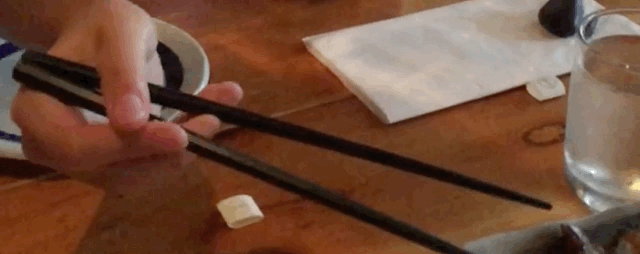
The human hand is built such that trying to extend and flex the proximal (second) knuckle to move the top chopstick is difficult, while the distal (first) knuckle remains extended during such move (below left). The same move is natural with the standard grip, because both distal knuckle and proximal knuckle extend and flex synchronously (below right).
Users of Vulcan Grip practice an even more severe form of flattened fingers. Compare the Idling Thumb (below left) to the Vulcan Grip (below right). Because of flattened fingers, both grips result in very little leverage and power.
Variant 2: Index finger curls over stick and thumb
There is a second variant of Idling Thumb where the index finger is not extended flat. Instead, it is curled, and it loops over the top chopstick to securely hook onto it, as done in Hook n Clamp, and Double Hook.
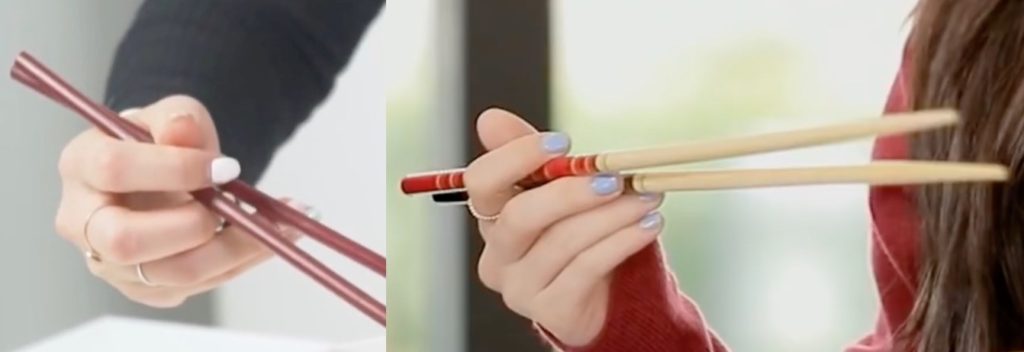
With this variant 2, the index finger also wraps around the tip of the thumb pad. This is different from variant one where the index finger and the thumb form a more recognizable cross. At a glance this may not seem like a big deal. But this small change alters how fingers grasp the top chopstick.
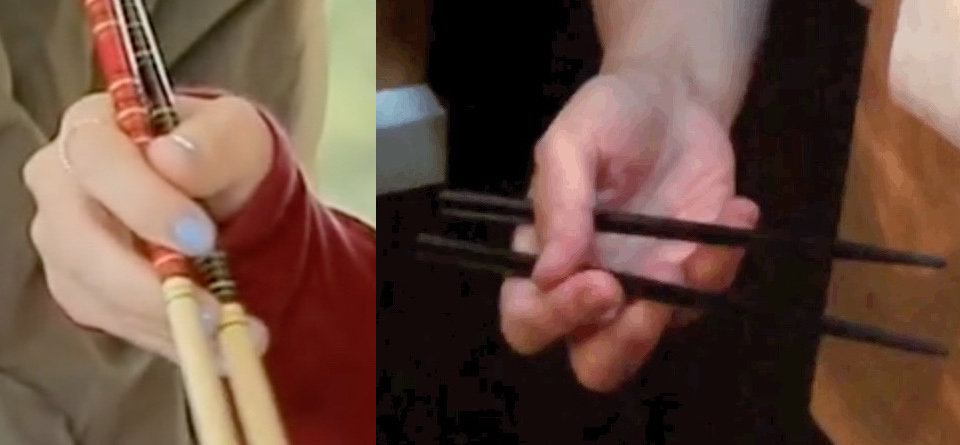
Variant 2 (above left) uses the index finger and the middle finger to sandwich the top chopstick from two opposite sides, where the index finger pushes on the stick in the same direction as the thumb joint. Variant 1 (above right) has the index finger pushing from the top instead. Its thumb joint, finger pad and middle finger knuckle form a tripod grasp closer to the Tripod Hold employed by Standard Grip.
Following images compare Variant 2 (left) to Standard Grip (right), lending an even more clear contrast.
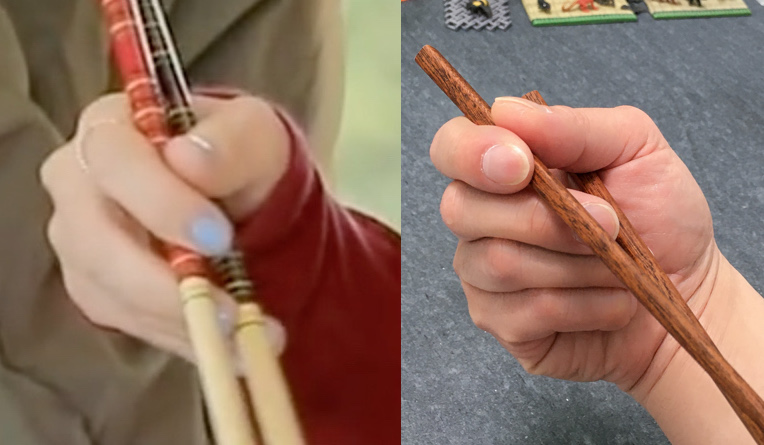
Here is another view of the same comparison. From this angle, it can be clearly see that the Tripod Hold in Standard Grip (right) supports the top chopstick from three equal-paced angles. Because of the non-tripod holding pattern of fingers in Variant 2 (left), even if part of the thumb pad is facing the top chopstick, the thumb pad cannot really roll the top chopstick using Planetary Gear principles as employed in Standard Grip. Furthermore, the index pad isn’t placed at on the top surface of the top chopstick, and as a result, the top stick is not as secured-held as it is in Standard Grip.
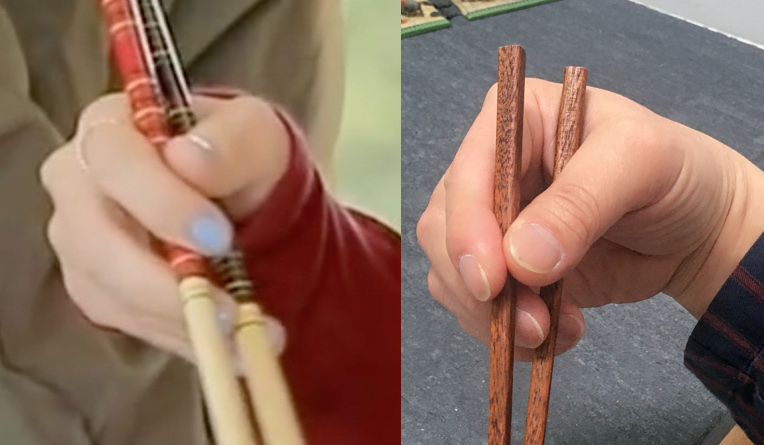
The end result is that finger mechanics of variant 1 and variant 2 suffer from the same issues, when compared to finger mechanics of Standard grip. We’ll presently discuss these.
Mechanical advantages at play in compression
The clip below on the left is a slow-motion capture of a user closing salad tongs using a pair of chopsticks. Note how the tip segment of the thumb is not used at all. Distal knuckles of index and middle fingers remain extended throughout the alternating motion – only the third knuckle of these two fingers extend and flex. On closing chopsticks, the tip segment and the center segment of the index finger are responsible for nudging the top chopstick. On opening chopsticks, the middle finger attempts to push it upward. During the actual motion to compress tongs, the top chopstick remains unrolled, as an evidence that no planetary gear train action has taken place. Compare this to the same alternating motion with the Standard grip on the right. Pay attention to the tip of the thumb.
The compression motion in the left video above shows that the rear of the top chopstick sits on the purlicue as the unsecured fulcrum of a third-class lever. The index finger exerts “effort” force in the middle of the chopstick, to produce a force against the load at the tip of the chopstick. This is completely different from the mechanical advantage produced by Standard Grip, shown above to the right. In Standard Grip, the planetary gear train action makes the mid point of the chopstick look like a moving pivot. This can be confirmed by noting how rear ends of the two chopsticks separate and come close together, throughout the alternating motion.
At a first glance, it may appear that the Idling Thumb has a larger mechanical advantage in the compression test, because the distance between the effort point and the fulcrum is larger. But this is only an illusion. Note that the purlicue “as a fulcrum” is an unsecured pivot. Nothing pins the top chopstick against the purlicue. If the tip segment and the center segment of the index finger remain bent, as they are in Standard Grip, an attempt to exert a “down effort” will cause the rear end of the chopstick to “shift up”. For this Idling Thumb motion to actually work, the user must flatten both segments of the index finger. This allows the entire index finger to mesh with the chopstick, and to force it to move in the way shown in the clip. This finger flattening contributes to the inability of Idling Thumb to exert extension forces, as we will presently discuss.
Mechanical advantages at play in extension
The clip below to the left is a slow-motion capture of a user opening salad tongs using a pair of chopsticks. Note how both thumb and index fingers are unemployed in this attempt at opening salad tongs. The flattened index finger from the previous compression is no position to help with extension now. Very little leverage is to be had, and almost no power is generated. In this struggle, the user has momentarily switched away from resting the bottom chopstick on the distal knuckle of the ring finger. The user compensates for the immobile top chopstick, by attempting to move the bottom chopstick instead, using the pulp of the ring finger. For more on the use of pulp areas, see the Vulcan Grip article. Compare this to the same alternating motion with the standard grip on the right. Again, pay attention to the tip of the thumb.
Comparison between users
Following videos capture three generations of users wielding the same Idling Thumb grip.
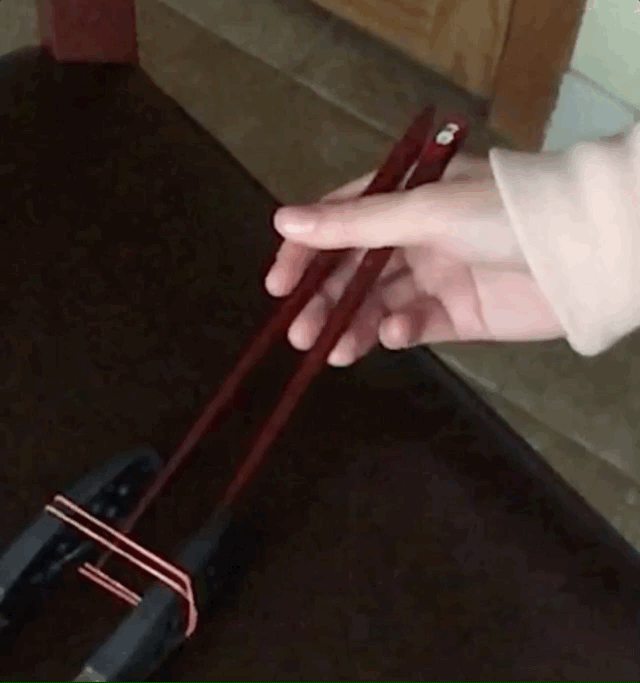
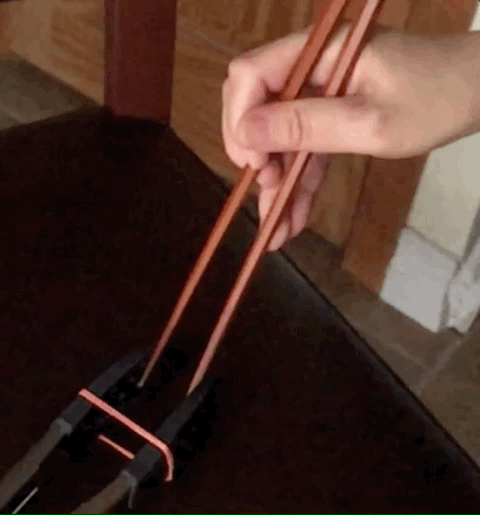
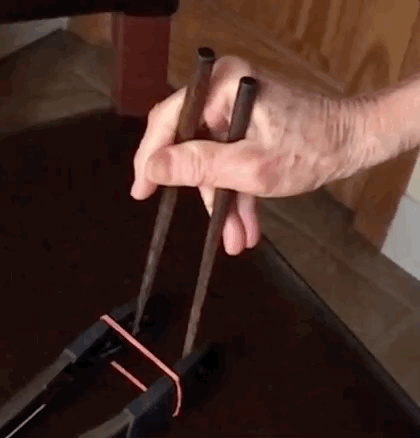
Air-quote gesture in Standard Grip
Having said all of the above, we still consider the Idling Thumb grip a close relative of the Standard grip. Other than the idling thumb, all other fingers are operating more or less like they would, in the Standard grip. For instance, the bottom chopstick is properly resting on the distal knuckle of the ring finger (except for occasional lapses when struggling to open salad tongs). The top chopstick is sandwiched between the tip of the index finger and the distal knuckle of the middle finger. The orientation of the thumb is correct.
It is surprising that a small change in the use of the tip of the thumb can affect the finger dynamics to this extent. Because of the idling thumb, the distance between chopsticks are shortened. The air quote gesture and the planetary gear train are disabled. For a comparison, observe the air quote gesture and chopstick twirling with the standard grip below.
Idling Thumb in real life situations
Despite shortcomings we have analyzed, Idling Thumb works quite well in real life. In most eating situations, chopsticks do not need to be excessively extended. Following video demonstrates how an Idling Thumb user picks up a chopstick rest.
Overlap between Idling Thumb and Turncoat
Many Standard Grip and Idling Thumb practitioners subconsciously shift the role of the middle finger from moving the top chopstick, to securing the bottom chopstick, when they compress these two chopsticks to pinch a food item. We call it the Turncoat grip, for the middle finger has switched allegiance away from the top chopstick.
When a Standard Grip user does this, they truly do switch to a proper Turncoat grip, with the pad of the thumb continuing to support and move the top chopstick. We discussed Kotoha switching from Standard Grip to Turncoat, in the WorldFriend article.
When an Idling Thumb practitioner does this, however, they are only momentarily adopting Turncoat, and not full-heartedly.
Dahyun from our TWICE article provides a good example. Following are pictures of Dahyun momentarily assigning the middle finger the role of supporting the bottom chopstick. Note how her thumb pad does not assist the top chopstick, unlike in true Turncoat grip. Also note that while the pad of the middle finger is resting on the bottom chopstick, most of the time the top chopstick is also resting on the knuckle of the middle finger.

This pseudo and momentary Turncoat adoption is in fact necessary for many Idling Thumb practitioners, because when pinching relatively small food items, the gap between the two chopsticks is much reduced, where the middle finger meets chopsticks. This is not a problem for Standard Grip practitioners, because they utilize the thumb pad, and thus propping up the top chopstick far enough away from the bottom chopstick. In Idling Thumb, the joint of the thumb, and not the pad, holds the top chopstick in place, thus substantially lowering the top chopstick. This in turn requires that the middle finger be sandwiched between the top chopstick and the bottom chopstick.
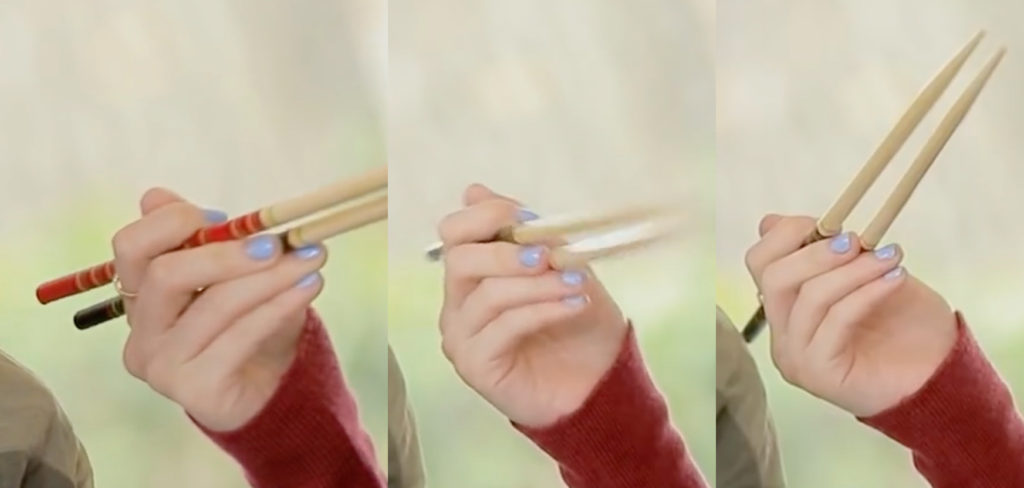
Hybrid with Lateral compression
In May 2021 we analyzed an excellent episode on chopsticks and chopsticking by World Friends YouTube channel. We published a writeup of this review in YouTube episode on chopsticking from WorldFriends.
Of relevance to Idling Thumb is the hybrid grip that Jane uses. Jane extends chopsticks apart with Idling Thumb, but closes them against food items with Lateral compression. This hybrid approach is also see in the Lateral Turncoat grip, where Turncoat extension is used in combination with Lateral compression. It is also similar to how Chicken Claws adopts a Lateral compression, and an Idling Thumb-like extension. But Chicken Claws, of course, takes it to the next level, with its super-wide chopstick extension range enabled by its special use of the thumb at the Max open posture.
Following images show the Closed posture (left) and the Open posture (right) from one part of the video.
Very soon we will have to find ways to name more combination grips like these…
Related grip: Double Hook
… well, we did. In August 2021, we found more examples of the hybrid from the previous section. And we named this grip the Double Hook grip.
Following pictures compare the extension mechanism of Chicken Claws (on the left) to Double Hook (center), and to Idling Thumb (on the right). The index finger and middle finger configuration of Double Hook resembles that of Chicken Claws (left). But the thumb pose of Double Hook resembles that of Idling Thumb (right).
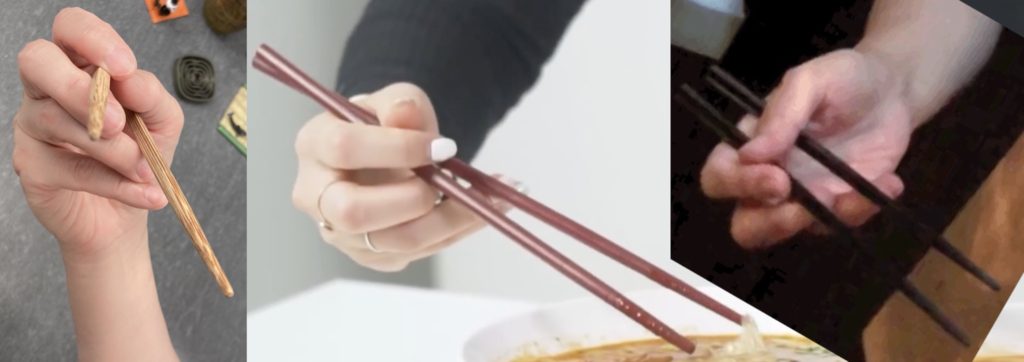
Following pictures compare the compression mechanism of Chicken Claws (on the left) to Double Hook (center), and to Idling Thumb (on the right). The primary difference is in where the thumb interacts with the top chopstick. In Chicken Claws (left) and Double Hook, the thumb base holds the top chopstick, and as a result, rear ends of chopsticks abut each other. In Idling Thumb (right), the thumb joint holds the top chopstick, thus giving rear ends enough distance from each other.
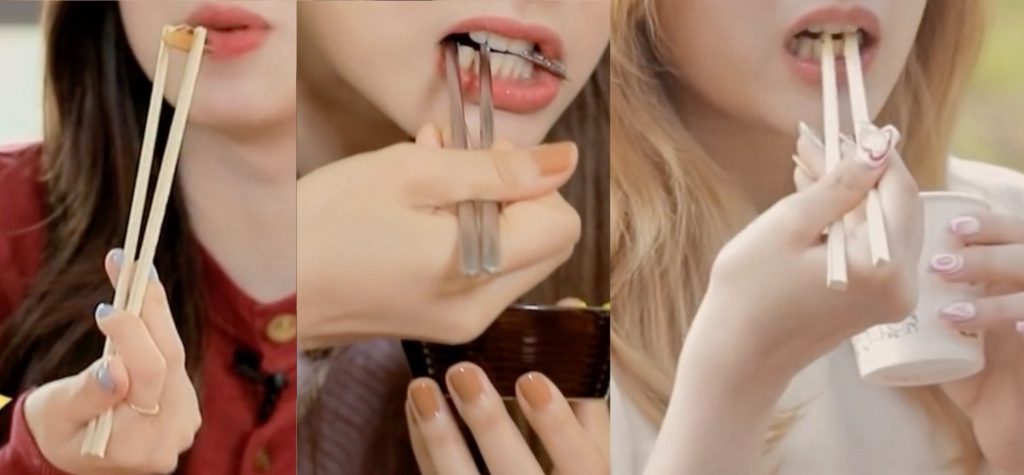
Sana’s Idling Thumb grip
In August 2021 we analyzed chopstick grips of all nine members of TWICE. While many members wield more than one grips, Sana specializes in Idling Thumb.
Sana always keeps the rear ends of chopsticks apart, true to Idling Thumb. She never uses the thumb pad to operate the top chopstick, another hallmark of Idling Thumb.

Following are views of the relaxed, open posture as seen from different perspectives.

When chopsticks need to be extended further apart, the index finger and the middle finger sandwich the top chopstick, and lift it away from the bottom chopstick.
Following show the relaxed, closed posture. Earlier we wrote about Dahyun, and how her Idling Thumb grip temporarily turned into a Turncoat grip. The relaxed, closed posture of Idling Thumb almost indistinguishable from the posture in Turncoat, as shown below.
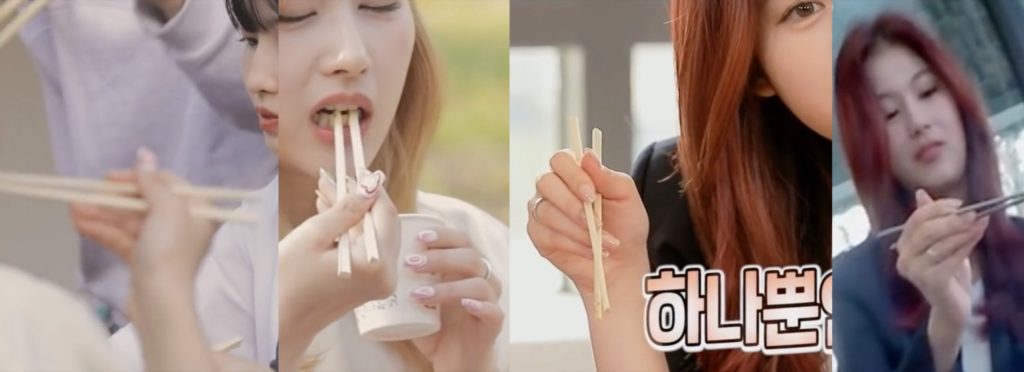
Compression postures shown below more clearly illustrate the transition from Idling Thumb to Turncoat. Note how the middle finger moves to the bottom chopstick quite often in this posture.

Idling Thumb.5
(2021-08) Idling Thumb.5 is a “.5” variant of Idling Thumb. By “.5” variant we refer to a modified finger support for the bottom chopstick where both the ring finger and the pinky provide support, instead of a single ring finger support. We have now incorporated this “.5” factor into our Classification of Chopstick Grips.
Tzuyu singlehandedly provided us with the first examples of two theoretical “.5” variants: Idling Thumb.5 and Double Hook.5. Tzuyu just helped us confirm this theory that many grips have a “.5” variant. Here is Tzuyu wielding Idling Thumb.5.
Tzuyu switches between Idling Thumb.5 and Double Hook.5 at will. These two “.5” grips are related to one another, just like Idling Thumb and Double Hook are.
Following pictures demonstrate her Idling Thumb.5 grip. Note how rear ends of chopsticks are separated at the open posture (below left). Notice that her index finger and middle finger are curved at the open posture. Note how the index finger flattens to squash down the top chopstick at the compression posture (below right). And most importantly, note how the bottom stick is supported by both the ring finger pad and the pinky knuckle – the hallmark of a “.5” variant.

Following pictures illustrate how Tzuyu picks up food with Idling Thumb.5. The movement starts with the index finger and the middle finger lifting the top chopstick. Then the index finger squashes the top chopstick downward, to pinch food. Lastly, she turns her wrist to pick the food up.

Learn new grips
Users of this alternative grip can add Standard Grip to their chopsticking repertoire, by simply learning to better make use of the tip segment of the thumb, to help twirl the top chopstick. Learn to twirl chopsticks, if you are interested.
If this Idling Thumb is your grip of choice, and you are curious about similar alternative grips, go check out the Chicken Claws grip and the Weak Standard grip. Also look at the family tree of alternative grips. Cheers!
Taiwanese: 憑段指頭母
This grip is known as 憑段指頭母 (Pīn-tōaⁿ chéng-thâu-bó) in Taiwanese. 憑段 (貧惰) means lazy in Taiwanese. Alternative 漢文: 貧惰指頭拇.
